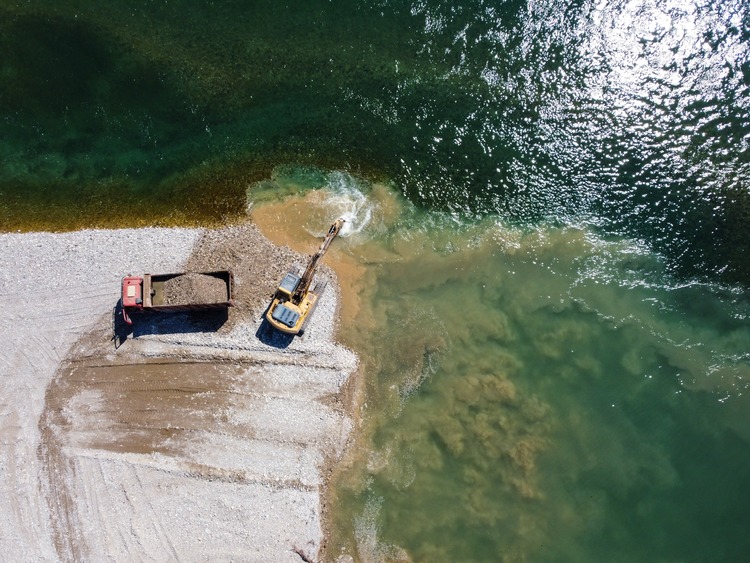
Discover more about sand mining, where it occurs, and why the process damages the environments in which it is carried out in
By
Every year, up to 50 billion tonnes of crushed rock, sand and gravel are extracted globally. Technically known as aggregate mining, the process is commonly referred to as sand mining, a practice which has tripled its activity in the past two decades alone.
Such a vast rise in sand mining can be attributed to one simple fact: the majority of building materials are made from either sand or gravel. Whether it be the glass in windows, or the cement and concrete supporting a building’s foundation, these materials are both virtually everywhere you look.
Enjoying this article? Check out our related reads:
And as cities continue to develop – with estimates suggesting up to 68 per cent of the world’s population will be living in one by 2050 – the demand for sand is likely to continue to go one way: up.
Take China as an example – 60 per cent of sand use worldwide is in the country. Already, China has used more cement (made of sand) since 2006 than the US did throughout the entirety of the 20th century.
Demand is soaring, then, and it’s no surprise that such a scenario is causing sand mining to develop into an unregulated industry in certain parts of the world, devastating the landscapes and ecosystems it is carried out in.
Here, we take a deep dive into the world of sand, the second most exploited natural resource in the world. Read on to learn more about how it is mined, the detrimental impacts of doing so, and how it can be more sustainably extracted.
How is it carried out?
Sand can be mined from a variety of locations, usually from an open pit. This can range from areas on land – such as sand dunes and beaches – to those with more watery origins, such as rivers and underwater ocean beds.

It’s important to note that not all sand is suitable for construction. For example, desert sand has grains far too smooth and rounded from high wind speeds to be used. The best sand to use, though, is river sand: its grains are well-sized and bind well in concrete.
Often, sand is mined near to where it is needed for construction purposes. For example, in the UK, sand travels only a short distance of 30km to 40km by road from where it is extracted.
However, removing sand is not without environmental repercussions. In fact, there are many to be considered when such activities are being carried out in the natural environment.
Environmental repercussions of sand mining
There are plenty of harmful consequences that sand mining can have on the surrounding environment, particularly those activities which dredge up river and coastal sand, vital to these specific ecosystems.
Firstly, the process causes a significant loss of biodiversity – as sand is dredged up and removed from ecosystems, particular animals and plants may no longer find such conditions hospitable.
Removing larger quantities of sand also has a vast impact on water flows, flood regulation and marine currents within particular environments. In particular, sand mining can lead to the removal of sediment from rivers, changing the composition of them and making their upstream and downstream flows sub-optimal. If excavating from deep underwater, noise pollution can impact certain marine creatures, and changes to the motion of the water can disturb species as well.
Other impacts include air pollution through transport emissions of vehicles carrying out such operations, water pollution in rivers, as well as severe erosion of beaches if sand mining is carried out in those locations.
In the long-term, sand mining also makes particular locations more vulnerable to extreme weather events such as floods, droughts and storm surges.
Sand mining ‘hotspots’
According to the Marine Sand Watch, some of the most intense sand mining occurs along China’s coastline and the east coast of the US.

Other major sand-mining hotspots are in locations within the North Sea and Southeast Asia, including the Mekong Delta.
Since sand mining was banned on China’s Yangtze river back in 2000, many excavators have moved to Poyang Lake, which has consequently experienced a plethora of negative changes from widening channels, to irregular, serrated shorelines. So significant is the extent of sand excavation in Poyang Lake that some researchers think it is the largest example of a sand mining operation in the world.
Tackling sand mining
Ultimately, we are currently mining sand at a faster rate than the planet can replace it. If we are to protect biodiversity, future species and the security of many valuable ecosystems, it is vital that sand mining’s popularity is quashed.
Already, some measures are being devised to help lessen its extensive use. In Singapore, some of the construction industry is using recycled glass waste instead of sand to produce 3D-printed concrete. The same concept is being applied to restore Louisiana’s coastline, after two students founded one of the state’s only glass recycling centres.
Elsewhere, developed countries are also being encouraged to look at the untapped potential of recycling building rubble to produce concrete, rather than using sand to make it anew.
The UN’s Environment Programme additionally developed a data platform – known as Marine Sand Watch – which uses AI combined with vessel tracking systems to identify and map sand mining across the world.
Perhaps there is also a glimmer of hope to be had in the fact, within safe levels, sand mining can sustainably occur in rivers. With the correct management tools, it may soon be possible to drop sand mining levels to within sustainable boundaries.
But for now, it is undeniable that sand mining poses a real, tangible threat to the sustainable future of many of our planet’s environments.



